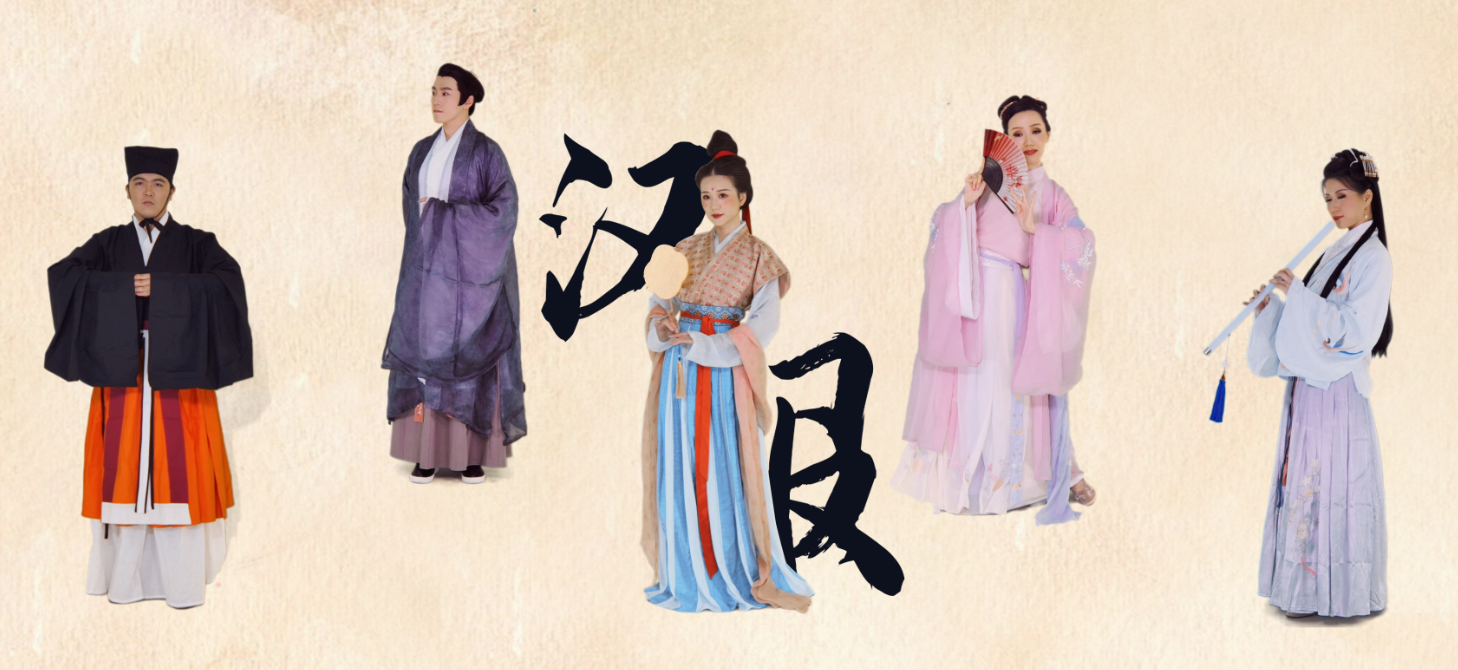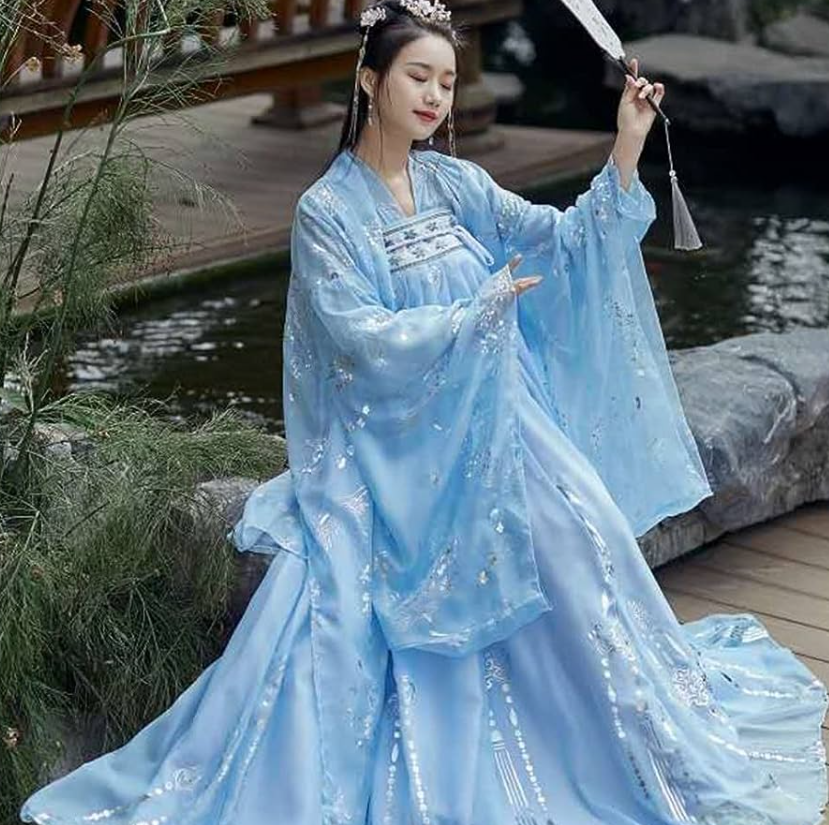The rules of Hanfu dictate appropriate seasonal wear, occasion-based choices, gender-specific designs, and integrate symbolism.
Rules and Etiquette for Wearing Hanfu
Seasonal Guidelines
When it comes to the seasons, Hanfu offers a wide range of options to suit various weather conditions. In summer, lighter fabrics like silk and linen are preferred. These materials allow the skin to breathe and keep you cool. You’ll often see people wearing sleeveless or short-sleeved variants during this time. In contrast, winter Hanfu is made from thicker materials such as wool or heavy brocades. Layering is also more common in colder months, where it’s not unusual to wear an inner garment paired with an outer robe.

Formal vs. Casual
Understanding the setting is crucial when selecting a Hanfu outfit. For formal occasions like weddings, festivals, or religious ceremonies, one might opt for a Shenyi, a long robe that signifies respect and formality. This robe is often adorned with intricate embroidery and might come in bold colors to represent joy and celebration.
On the other hand, casual Hanfu like Ruqun and Zhongyi are more suited for everyday wear. These are simpler in design and might include minimal embroidery. Ruqun, in particular, is popular among young women and can be seen in various modern adaptations.
Gender-Specific Rules
Gender plays a role in Hanfu fashion, although the lines can sometimes be blurred. Traditionally, men would wear robes that are straight-cut and less adorned. These are often paired with a headpiece that signifies their social status. Women’s Hanfu, on the other hand, is usually more intricate and may include elaborate decorations such as floral embroidery or beadwork. In some cases, women wear Ruqun, which is a type of Hanfu consisting of a top garment and a skirt.
Hanfu in Modern Society
Cultural Revival
The renaissance of Hanfu in modern Chinese society is nothing short of remarkable. After years of fading into obscurity due to various historical and political reasons, Hanfu has seen a resurgence in recent years, particularly among the younger generation. Social media platforms like Weibo and various Hanfu groups actively promote the wearing of traditional attire, not only as a fashion statement but also as a mark of cultural identity. In urban centers like Beijing and Shanghai, you can often find Hanfu enthusiasts gathering in historical landmarks for photoshoots, community events, and cultural displays.
Modern Variations
With the advancement of technology and the melding of different fashion styles, Hanfu has adapted to modern tastes without losing its traditional essence. Designers are experimenting with new materials, patterns, and cuts to make Hanfu more accessible for daily wear. For instance, the Ruqun now comes in various skirt lengths and materials to suit different occasions and preferences. There are also fusion styles that blend Hanfu with Western fashion elements, leading to creations that are both unique and deeply rooted in tradition.
Influence in Popular Media
One of the key factors driving the popularity of Hanfu is its frequent appearance in popular media. Movies, television dramas, and even animated series often feature characters dressed in traditional Hanfu, evoking a sense of nostalgia and pride. This representation is not just limited to China but has reached international audiences, largely thanks to streaming services. Moreover, celebrities and influencers often don Hanfu for public appearances, magazine shoots, and social media, thereby contributing to its widespread popularity.
Symbolism and Meaning
Colors
The choice of colors in Hanfu is far from arbitrary; each hue carries specific symbolic meanings deeply rooted in Chinese culture and philosophy. For example, red, commonly seen in weddings and festive occasions, represents happiness and good fortune. Yellow, reserved for royalty in historical times, signifies power and wealth. Blue and green often represent vitality and growth and are thus popular during spring festivals. By understanding the symbolism behind these colors, one can fully appreciate the layers of meaning that a simple Hanfu garment can carry.
Patterns
Patterns and motifs are another aspect where symbolism plays a significant role. Dragons, phoenixes, and certain floral patterns like plum blossoms and chrysanthemums are frequent features. Each pattern has its own set of meanings; for instance, a dragon usually signifies power and majesty, whereas a phoenix represents grace and virtue. Yunjin, a specific type of brocade, often incorporates complex patterns that require skilled craftsmanship, making it a sought-after fabric for important ceremonies.
Accessories
Accessories like hairpins, belts, and jewelry are not mere decorations but are often imbued with symbolic significance. For example, jade accessories are not only aesthetically pleasing but also symbolize purity and moral integrity. Hairpins made from silver or gold may carry intricate designs of animals or mythical creatures, each with its own meaning. Such accessories often complete the Hanfu outfit and make it occasion-appropriate.
The Politics of Hanfu
National Identity
Hanfu is more than a style of clothing; for many, it’s a symbol of cultural and national identity. The resurgence of Hanfu in recent years has been tied to a broader movement to reclaim and celebrate traditional Chinese culture. This aligns with ongoing efforts to strengthen national identity, both within China and among overseas Chinese communities. Some proponents argue that wearing Hanfu can be a political act, an assertion of cultural pride in the face of globalization. In this context, Hanfu becomes more than fashion; it is a statement of belonging and a reclamation of historical and cultural roots.
Controversies
While Hanfu has seen a revival as a form of cultural expression, it’s not without its controversies. One major point of debate is the question of exclusivity and representation. Because Hanfu is specifically tied to the Han Chinese ethnicity, concerns arise about its implications for the diverse range of ethnic groups within China. There are also debates about the appropriation of Hanfu and whether it should be exclusive to people of Chinese descent.
Another contentious issue is the use of Hanfu in political or nationalist agendas. Given its deep historical and cultural roots, Hanfu can easily be leveraged for ideological purposes, which has led to caution and criticism from various quarters.

Hanfu in the Global Context
Influence on Other Traditional Dresses
As a cornerstone of traditional Chinese culture, Hanfu has also left its mark on the traditional garments of other nations. For instance, the Vietnamese Áo Dài and the Korean Hanbok share similarities with Hanfu, especially in their older forms. Elements like flowing robes, layers, and wide sleeves can be traced back to the influence of Hanfu. Some experts suggest that trade routes like the Silk Road played a role in spreading Hanfu’s stylistic elements to other cultures.
Popularity Abroad
Hanfu is not just gaining traction in China; its appeal is global. Due in part to the influence of Chinese cinema and television, as well as cultural festivals that showcase Hanfu, international interest in this traditional garment has spiked. Specialty stores selling Hanfu have appeared in cities like New York, London, and Sydney, catering to both Chinese diaspora and non-Chinese enthusiasts alike. Universities often have Hanfu societies or clubs, where people gather to learn about the attire, its history, and its cultural significance. Online platforms also provide a space for global communities to discuss, purchase, and showcase Hanfu.
What types of fabric are commonly used in Hanfu?
How much does a Hanfu costume typically cost?
How efficient is Hanfu in terms of comfort?
Are there specific Hanfu styles for different ages?
How long does a quality Hanfu garment last?
What are the typical dimensions for Hanfu?
What are the pros and cons of wearing Hanfu?
- Cultural significance
- Comfortable
- Versatile for different occasions
- Can be expensive (up to $500 for elaborate sets)
- Might be seen as impractical for everyday wear due to its elaborate nature